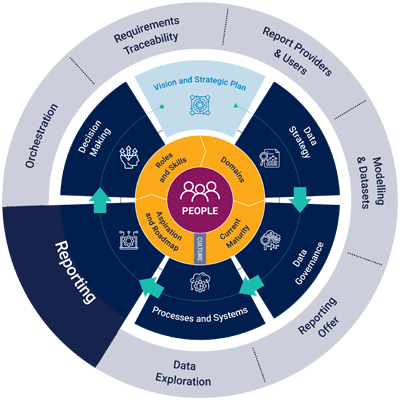Reporting
The responsibilities and processes of reporting information within the data maturity framework.
Who owns reporting?

The production and delivery of reporting falls within the remit of the chief data officer.
Where this post is not in place, ownership may rest with:
- director of IT/head of IT.
- director of planning/business Intelligence.
- head of management information systems/MIS manager
Reporting is delivered by business intelligence analysts, data analysts, ETL developers, data warehouse developers and architects. Subject matter experts are responsible for sharing requirements based on administrative and strategic needs.
The role of reporting
Reporting is the transformation of data tables into information – this is when data becomes visible to most teams. Reporting should be accessible, timely, defined, accurate, user focused and trusted. At scale, it should be catalogued, explicitly linked to decision-making needs, reviewed and archived as required.
Business requirements and effective processes to join, model and automatically process data are needed to:
- Support administrative activity.
- Meet statutory and regulatory obligations.
- Add value through the analysis of trends and delivery of forecasting/predictions.
- Enable confident decision making.
Data tables are typically replicated to enable live/near live reporting or snapshotted at a census point to be modelled for trend analysis. Programmatically joining tables, applying business rules, rectifying poor data quality and formatting suitably for use in visualisation software or onward analysis requires a technical skillset combined with analytical ability and effective communication skills. It is common for this work to be performed across several roles, with complementary skills, experience and business knowledge.
Reporting and data maturity
Mature organisations have a defined reporting architecture, detailing business areas, business questions and agreed systems of record. Automated integrated reporting is delivered from disparate systems and datasets and derived fields, reference and master data are managed consistently across outputs.
All parts of the organisation have access to a core level of information and defined datasets service ad hoc queries from business specialists. Reports are scoped for use by specific audiences in a format that meets user needs and are accessed from a structured central repository. In larger providers, teams collaborate across functional areas, working to agreed standards and processes. These organisations are considering how new technologies can enhance organisation-wide analytics and are trialling AI and machine learning tools.
Where universities and colleges are less mature, reporting provision is reactive, with repeated, siloed ad hoc activity used to create and clean datasets. There is minimal automation of data processing and, where used, data tables are manually uploaded into reporting tools. There is little visibility of skillsets, provision is often time lagged and report writers may feel overwhelmed.
It is common for there to be single points of failure in relation to business knowledge or technical skills. Business users cannot access what they need, or in some cases take on elements of report provision themselves, which may lead to multiple reports that contradict each other.
Reporting themes
We have divided reporting into the following six thematic areas.
Requirements traceability
The gathering, analysis and translation of reporting requirements into technical specifications to move away from ad hoc delivery
Orchestration
The extraction and transformation of data from systems or a data platform into a reporting layer or repository.
Modelling and datasets
The creation of datasets in a reporting layer or repository, their audience and purpose.
Reporting offer
The provision and deployment of effective reporting.
Data exploration
The investigation of how data can support new approaches.
Report providers and users
The definition of reporting roles and functional collaboration.
Decision making
All members of staff need information to make decisions, some strategic, some administrative.
The data maturity framework is copyright Jisc and made available under CC BY-NC-ND. Find out more about using content from the data maturity framework.